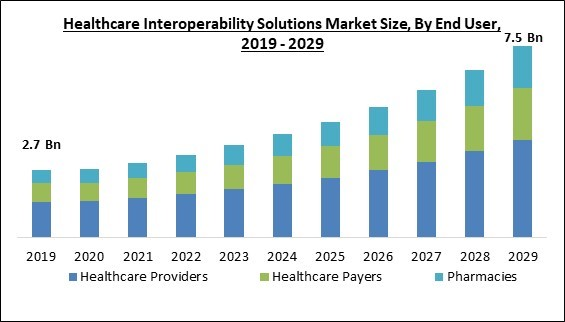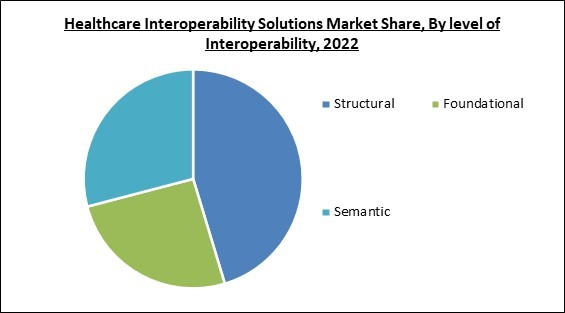Interoperability in healthcare belongs to the timely & secure integration, access, and utilization of electronic healthcare data to optimize the health results of people and groups. Interoperability and data sharing are likely to become increasingly important for providing good healthcare as populations throughout the world age and people live longer. The ability of multiple systems to exchange health data and use it after receiving it is known as interoperability.
When using offline mode, sharing large amounts of data is challenging. As a result, the acceptance of healthcare interoperability solutions within the healthcare industry is crucial since they make it simple to share and store massive data, which fuels the market for healthcare interoperability solutions. Also, the market need for healthcare interoperability solutions has increased due to the government's adoption of different healthcare reforms.
Data exchange throughout the value chain and integrating all medical devices are essential to the future of healthcare. With data-driven technology, the healthcare industry must transition from its current curative approach to a completely preventive care model. The best way healthcare systems can enhance the patient experience is by updating systems to incorporate the newest technologies and enhancing security. In the upcoming years, system interoperability is expected to enhance the state of healthcare as a whole.
Healthcare interoperability solutions help in understanding the efficacy of the pharmaceuticals produced and the capability of the healthcare system to distribute these treatments to patients in need. Knowledge that promotes public health is crucial. As a result, it is anticipated that the market for healthcare interoperability solutions will grow steadily in the upcoming years. As the need for high-quality healthcare increases, the government promotes information interoperability through initiatives and advertising. It is predicted that the market will be supported by the government's and public organizations' efforts.
COVID-19 Impact Analysis
Accurate patient data, electronic patient records, interoperability, and cyber security remain the main concern for healthcare organizations. Since healthcare organizations have quickly shifted to online settings and remote care, E-health played a big part in shifting healthcare services from products to services, which raised market demand. Furthermore, the population's growing interest in receiving healthcare online through gadgets and applications and the speedy advancement of home healthcare delivery technologies further helped the market grow. Thus, the healthcare interoperability solutions market has witnessed a positive impact due to the outspread of the COVID-19 pandemic.Market Growth Factors
Advent of novel medical technologies
Interoperability can lower waste and total costs while enhancing patient safety by lowering radiation or invasive procedure exposure. The greater access to pertinent and longitudinal clinical data at the time of service made possible by interoperability may enhance clinical treatment. Fast Healthcare Interoperability Resources (FHIR), an open-source standards framework for healthcare data, is based on the earlier HL7 standards framework. FHIR was created to make it easier to move healthcare data between systems. The emergence of such new technologies is estimated to support the market's growth in the upcoming years.Enhancements in software technology to support real time data exchange
Software interoperability is defined as the capacity of various solutions to communicate with one another in a straightforward and unrestricted manner. Data can be sent in real time between interoperable systems without requiring expert IT assistance or code running in the background. It might be anything as straightforward as a CRM system that interfaces highly with automation software to establish a data flow between sales and marketing. Alternatively, the team could set up a comprehensive tech stack of interconnected apps that can send data to streamline operations. These factors are anticipated to support the expansion of the healthcare interoperability solutions market.Market Restraining Factors
Rising complexity as a result of lack of consistent data
Every department in a hospital facility now has its own IT system, from emergency services to laboratories, radiology, and patient rooms, illustrating how big and complex the healthcare IT landscape has become. Hospitals globally are under pressure to improve efficiency & patient outcomes due to the enormous amount of healthcare data they produce every day. They are limited in what they can do with the data they gather by the development of technologically advanced medical equipment, secretive troves of unstructured data, and incompatibility with other systems. As a result of this, the increased complexity may hinder the growth of the healthcare interoperability solutions market.Component Outlook
By component, the healthcare interoperability solutions market is segmented into software solutions and services. In 2022, the services segment held the highest revenue share in the healthcare interoperability solutions market. This can be attributable to the paradigm change toward cloud computing & cloud-based platforms to lower operating expenses for better & faster business application & process performance. Other factors that contribute to the segment's growth include recurrent purchases of services like software maintenance and updates.Level of Interoperability Outlook
Based on level of interoperability, the healthcare interoperability solutions market is bifurcated into foundational interoperability, structural interoperability, and semantic interoperability. The semantic interoperability segment recorded a remarkable revenue share in the healthcare interoperability solutions market in 2022. The most reliable interoperability method now on the market, semantic interoperability, allows for the transmission of information between more than two systems. Via possibly dissimilar EHR and other systems, semantic interoperability facilitates the electronic interchange of patient data among authorized parties and providers to increase healthcare delivery's efficiency, effectiveness, and safety.End-users Outlook
On the basis of end users, the healthcare interoperability solutions market is categorized into healthcare providers, healthcare payers and pharmacies. In 2022, the healthcare providers segment dominated the healthcare interoperability solutions market. Increased patient volume, the need to contain increasing healthcare expenses, and government mandates are factors contributing to the growth of this market segment. This element is anticipated to accelerate the market's growth for healthcare interoperability solutions.Regional Outlook
Region wise, the healthcare interoperability solutions market is analyzed across North America, Europe, Asia Pacific and LAMEA. In 2022, the North America region led the healthcare interoperability solutions market by generating the largest revenue share. Some key drivers that influence the acceptance of interoperability solutions in this region include the increased demand for effective healthcare services, the need to reduce healthcare costs, and the successful implementation of EHR by healthcare organizations.The Cardinal Matrix - Healthcare Interoperability Solutions Market Competition Analysis
The major strategies followed by the market participants are Partnerships. Based on the Analysis presented in the Cardinal matrix; Oracle Corporation (Cerner Corporation) is the forerunner in the Healthcare Interoperability Solutions Market. Companies such as Koninklijke Philips N.V., Wipro Limited, and Veradigm, Inc. are some of the key innovators in Healthcare Interoperability Solutions Market.
The market research report covers the analysis of key stakeholders of the market. Key companies profiled in the report include Oracle Corporation (Cerner Corporation), Epic Systems Corporation, Virtusa Corporation, Wipro Limited, Koninklijke Philips N.V., Veradigm, Inc., Cognizant Technology Solutions Corporation, Onyx technology LLC, Orion Health Group Limited, and InterSystems Corporation.
Recent Strategies Deployed in Healthcare Interoperability Solutions Market
Partnerships, Collaborations and Agreements:
- Apr-2023: Cognizant joined hands with Microsoft, a US-based technology company. The collaboration focuses on providing healthcare providers and payers with easily approach state-of-the-art technology solutions, smooth claims management, etc. This collaboration enables Cognizant to offer supreme technology and capabilities that would benefit its clients.
- Feb-2023: Veradigm came into partnership with Jopari Solutions, a US-based operator of health information technology company. The partnership focuses on delivering electronic medical claim and attachment solutions to their customers using Payerpath. These solutions would benefit the company's Payerpath users by making the claims process, and reimbursement process, simpler and more efficient.
- Jan-2023: Royal Philips extended its partnership with Masimo, a US-based medical technology company. The expansion of the partnership focuses on integrating patient monitoring capabilities in home telehealth applications through Masimo W1 advanced health tracking watch.
- Sep-2022: InterSystems came into partnership with Northwest London Integrated Care System. The partnership involves offering cloud-based interoperability service by making use of HealthShare Health Connect Cloud.
- Jul-2021: Orion Health partnered with Idaho Health Data Exchange, Idaho’s statewide designated health information exchange (HIE). The partnership includes migrating IHDE to Orion's HIE platform, which would result in enhanced capabilities, interoperability, and data sharing, thereby benefiting both healthcare providers and patients.
- Jul-2021: Royal Philips collaborated with Cognizant, a world-leading professional services firm. Through this collaboration, the companies aimed to design end-to-end digital health solutions which would allow healthcare organizations & life sciences companies to enhance patient care & accelerate clinical trials.
- Jan-2021: Onyx Technology teamed up with AMA Innovations, part of the American Medical Association. The collaboration involves jointly developing an HL7 FHIR-based interoperability platform intended to connect social care networks and healthcare providers. Moreover, through this collaboration, the companies also intend to develop a secure messaging system, which would allow physicians and other team members to share messages, patient data, and referrals with community-based organizations.
Product Launches and Product Expansions:
- Mar-2022: Philips launched HealthSuite Interoperability. HealthSuite Interoperability is a cloud-based IT platform intended for the healthcare industry, that possesses the ability to cater to multiple workflow needs. The new platform supports all data types and formats, including images, genomics, and pathology, among others, and also supports EMR vendors. Additionally, the platform's clinical data repository enables customers to store, manage data, and the ability to design value-driving solutions including health image exchanges.
Acquisitions and Mergers:
- Jan-2021: Koninklijke Philips N.V. took over Capsule Technologies, Inc., a clinical surveillance, patient monitoring, and medical device integration provider for hospitals. With this acquisition, Philips would enhance their medical device integration platform and strengthen its workflow in ICUs and care settings in the hospital.
Scope of the Study
By End-user
- Healthcare Providers
- Hospitals & Clinics
- Long-term Care Centers
- Diagnostic & Imaging Centers
- Others
- Healthcare Payers
- Pharmacies
By level of Interoperability
- Structural
- Foundational
- Semantic
By Type
- Services
- Software
- EHR interoperability solutions
- Lab system interoperability solutions
- Imaging system interoperability solutions
- Enterprise interoperability solutions
- Healthcare information exchange interoperability solutions
- Others
By Geography
- North America
- US
- Canada
- Mexico
- Rest of North America
- Europe
- Germany
- UK
- France
- Russia
- Spain
- Italy
- Rest of Europe
- Asia Pacific
- China
- Japan
- India
- South Korea
- Singapore
- Malaysia
- Rest of Asia Pacific
- LAMEA
- Brazil
- Argentina
- UAE
- Saudi Arabia
- South Africa
- Nigeria
- Rest of LAMEA
Key Market Players
List of Companies Profiled in the Report:
- Oracle Corporation (Cerner Corporation)
- Epic Systems Corporation
- Virtusa Corporation
- Wipro Limited
- Koninklijke Philips N.V.
- Veradigm, Inc.
- Cognizant Technology Solutions Corporation
- Onyx technology LLC
- Orion Health Group Limited
- InterSystems Corporation
Unique Offerings
- Exhaustive coverage
- The highest number of Market tables and figures
- Subscription-based model available
- Guaranteed best price
- Assured post sales research support with 10% customization free
Table of Contents
Companies Mentioned
- Oracle Corporation (Cerner Corporation)
- Epic Systems Corporation
- Virtusa Corporation
- Wipro Limited
- Koninklijke Philips N.V.
- Veradigm, Inc.
- Cognizant Technology Solutions Corporation
- Onyx technology LLC
- Orion Health Group Limited
- InterSystems Corporation











